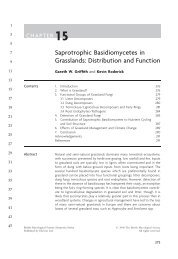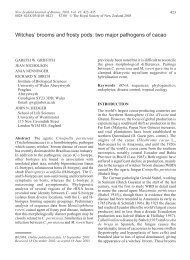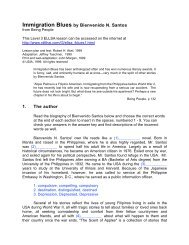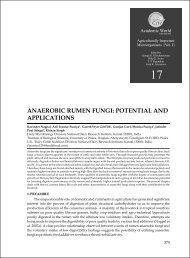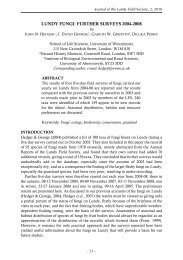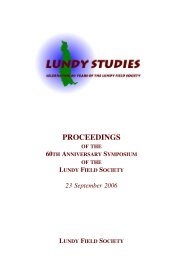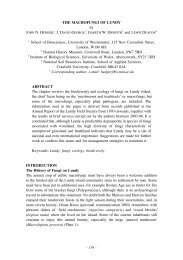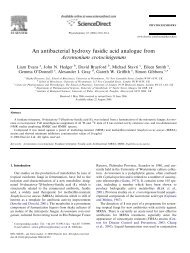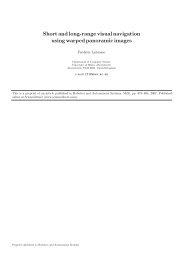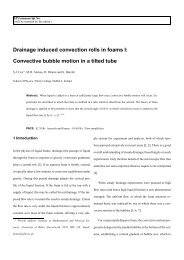Chytridiomycota - Users Site
Chytridiomycota - Users Site
Chytridiomycota - Users Site
You also want an ePaper? Increase the reach of your titles
YUMPU automatically turns print PDFs into web optimized ePapers that Google loves.
whereas most species are infrequent and scarce to<br />
rare (Letcher and Powell 2001, Letcher et al 2004a).<br />
The most prominent morphological feature of the<br />
chytrid body, or thallus, is the sporangium (FIG. 1).<br />
The sporangium is a sac-like structure in which<br />
internal divisions of the protoplasm result in production<br />
of zoospores. These zoospore-producing<br />
sporangia (zoosporangia) are thin-walled (FIG. 1k)<br />
whereas resting spores are thick-walled structures<br />
(FIG. 1a, l) that may germinate to produce a sporangium<br />
after a dormant period. Zoosporangia always are<br />
produced asexually, but resting spores may be<br />
sexually or asexually formed. Eucarpic chytrids are<br />
those that consist of a sporangium and filamentous<br />
rhizoids (FIG. 1k). In contrast holocarpic chytrids<br />
produce thalli that are entirely converted to sporangia<br />
during reproduction. Chytrid thalli can be either<br />
monocentric, in which an individual produces only<br />
a single sporangium (FIG. 1g), or polycentric, in<br />
which an individual is composed of multiple sporangia<br />
produced on a network of rhizoids termed<br />
a rhizomycelium (FIG. 1j). Classically chytrids also<br />
were described on the basis of whether they grow on<br />
(epibiotic, FIG. 1h) or within (endobiotic, FIG. 1a)<br />
their substrate. Other characteristics historically used<br />
for taxonomy include the presence of a lid-like<br />
operculum (FIG. 1e), which opens to allow zoospore<br />
release from a sporangium (Sparrow 1960), and the<br />
apophysis (FIG. 1i), which is a subsporangial swelling.<br />
Zoospores are unwalled cells, usually 2–10 mm<br />
diam, which contain a single nucleus and, with the<br />
exception of some genera of the Neocallimastigales,<br />
are propelled by a single posteriorly oriented whiplash<br />
flagellum (FIG. 1b, m). Considerable effort has<br />
been placed on understanding the ultrastructure of<br />
the zoospore with electron microscopy; these studies<br />
have produced a wealth of information about the<br />
complexity of the internal contents of the spores. Two<br />
character-rich components of the zoospores can be<br />
identified: the flagellar apparatus, basal bodies and<br />
associated structures (Barr 1981), and the microbodylipid<br />
globule complex (MLC, Powell 1978).<br />
The <strong>Chytridiomycota</strong> is divided into five orders<br />
based primarily on the mode of reproduction and<br />
ultrastructure of the zoospore. Three groups can be<br />
distinguished largely on the basis of life cycle and<br />
gross morphology: the oogamous Monoblepharidales;<br />
the Blastocladiales displaying sporic meiosis and the<br />
alternation of sporophytic and gametophytic generations;<br />
and the Chytridiales, a group characterized by<br />
zygotic meiosis. A fourth order, Spizellomycetales, was<br />
separated from the Chytridiales on the basis of<br />
distinctive ultrastructural character states (Barr<br />
1980), and a fifth order, Neocallimastigales, occurs<br />
exclusively as anaerobic symbionts of the rumen.<br />
Mycologia myco-98-06-18.3d 4/1/07 13:38:39 861 Cust # 06-083R<br />
JAMES ET AL: PHYLOGENY OF CHYTRID FUNGI 861<br />
Chytridiales is the largest of the orders (more than 75<br />
genera) and the classification of this group has been<br />
variously approached using developmental, sporangial<br />
and more recently ultrastructural characters.<br />
Sparrow (1960) considered the operculum to be<br />
a defining characteristic and created two series of<br />
families based on whether sporangia were operculate.<br />
In contrast Whiffen (1944), Roane and Paterson<br />
(1974) and Barr (1978) suggested development could<br />
be used to divide the Chytridiales into families.<br />
Systems of classification based on morphology and<br />
those based on development of the thallus and<br />
sporangium both have been shown by molecular<br />
phylogenetics to be inaccurate in defining genera and<br />
families of Chytridiales (James et al 2000, Letcher et al<br />
2004b).<br />
Molecular phylogenies with 18S rDNA have suggested<br />
that both the <strong>Chytridiomycota</strong> and Chytridiales<br />
might not be monophyletic (James et al 2000).<br />
Phylogenies based on data from entire mitochondrial<br />
genomes (Seif et al 2005) have suggested strongly that<br />
two main lineages exist within the <strong>Chytridiomycota</strong>—<br />
the Blastocladiales and the remaining four orders<br />
(the ‘‘core chytrid clade’’). In this paper we present<br />
a new dataset that includes an analysis of most chytrid<br />
18S rDNA data in conjunction with sequence data for<br />
the entire rRNA operon (18S, 28S and 5.8S). These<br />
data provide a comprehensive view of chytrid phylogeny<br />
and define four major lineages of flagellated<br />
Fungi.<br />
MATERIALS AND METHODS<br />
Our dataset consists of taxa for which most of the rRNA<br />
operon was sequenced (18S+28S+5.8S subunits, n 5 54) as<br />
well as chytrid taxa represented only by 18S data (n 5 49)<br />
and additional fungal, animal and Mesomycetozoae taxa (n<br />
5 21; complete operon with one exception, Diaphanoeca<br />
grandis). GenBank accession numbers and strain/voucher<br />
data are provided (SUPPLEMENTARY TABLE I). Data gathered<br />
for the full operon were obtained by PCR, primarily with<br />
primers SR1R and LR12 (Vilgalys and Hester 1990) using<br />
LATaq (TaKaRa), with these thermocycling conditions:<br />
94 C for 1 min followed by 35 cycles of denaturing at 94 C<br />
for 30 s, annealing at 55 C for 30 s, extension at 72 C for<br />
5 min and a 10 min final extension at 72 C. Amplicons<br />
generally were cloned into pCR2.1-TOPO (Invitrogen).<br />
The three gene regions were aligned by eye with GeneDoc<br />
v2.6 (http://www.cris.com/,Ketchup/genedoc.shtml) and<br />
combined into one supermatrix with MacClade 4.05 (Maddison<br />
and Maddison 2002). Regions of ambiguous alignment<br />
were excluded from further analysis leaving 4109 included<br />
characters, 1388 of which are parsimony informative. We<br />
estimated the phylogeny with MrBayes v3.1 (Huelsenbeck<br />
and Ronquist 2001) by four independent runs with the<br />
GTR+I+C model of evolution, sampling trees every 500<br />
generations for 10 3 10 6 generations. We also assessed



